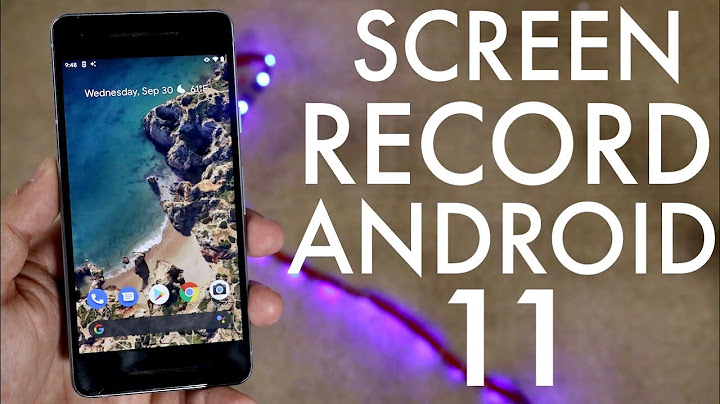There are many times when recording your Mac screen can come in handy. Maybe you want to create a screencast tutorial. Perhaps you’re creating a business presentation. Or maybe you’re interested in making video notes for yourself. Show
Whatever the reason, it’s simple and easy to do. So here’s how to record the screen on your Mac and easily start and stop recordings with a few different methods. How to Screen Record on a Mac Using the Screenshot UtilityYou may be tempted to install third-party screen recorders for your Mac, but actually, the easiest method to record your Mac’s screen is by using the Screenshot Utility. This tool lets you capture screen recordings in addition to screenshots. To open the utility, press Cmd + Shift + 5 on your keyboard. At the bottom of the window that appears, you’ll see two options—Record Entire Screen and Record Selected Portion.
If you choose Record Entire Screen, a camera icon will appear. This is handy if you use more than one monitor. Just move the camera to the screen you want to record and click for the recording to begin. If you choose Record Selected Portion, drag the corners of the box you see to adjust the frame size. You can also move the box to a different area on your screen. Clicking on Options allows you to select various options for your Mac screen recording. This includes choosing your desired microphone, where you want to save your recording, if you want to record mouse clicks, and more. Once you’re ready, hit the Record button to start the recording.
How to Stop Screen Recording on Your MacOnce you’ve completed the recording, you may be unsure about how to stop it, as the screenshot utility window won’t be visible anymore. Instead, you should see a small Stop icon in the macOS menu bar. Click on it to stop the screen recording on your Mac.
You can also hit Cmd + Control + Esc to stop recording. Or, hit Cmd + Shift + 5 and the screenshot bar will reappear with an option to stop recording. The recording will automatically save to the Desktop, and you’ll see a preview of it in the bottom-right corner of your screen (similar to when you take a screenshot). If you click on this preview, you’ll be able to see the entire recording and trim it if needed. The Benefits of Recording With the Screenshot Utility
How to Screen Record on a Mac Using QuickTime PlayerAn alternative method to record your Mac’s screen is to use QuickTime Player. QuickTime Player uses the same Screenshot utility tool we described above, but the difference is that you control everything directly from the QuickTime Player app instead. This may be useful for Macs running macOS versions earlier than macOS Mojave. To record using the QuickTime Player, open the app, then select File > New Screen Recording from the menu bar.
This launches an overlay, allowing you to select various options to record your screen. You can choose to either Record Entire Screen or Record Selected Portion, similar to the Screenshot utility. Once everything’s set up, start recording by clicking the Record button. To stop screen recording on your Mac, click on the Stop icon in the macOS menu bar. The recorded video will open immediately. You can choose to edit it as required (using Trim or Rotate tools). Once you’re done, simply select File > Save or hit Cmd + S on your keyboard to save the video to your desired location. The Benefits of Screen Recording With QuickTime Player
How to Record System Audio in Screen RecordingsBoth of the options listed above only allow you to use a microphone to record the audio. This is handy if you want to record a voice-over or a podcast, but it’s ineffective if you want to record the system audio. Fortunately, there is a workaround that involves installing a free audio driver on your Mac to record system audio during screen recordings. How to Screen Record on a Mac With Third-Party AppsWith the above two options, there’s little reason to seek a third-party app for recording your Mac screen unless you want or need more features. If you’re unsatisfied with the built-in options, OBS Studio is our favorite third-party freeware to use to record your Mac’s screen instead. OBS Studio
The consensus among both casual and hardcore users is that there’s no freeware screen recording utility as good as OBS Studio. The app offers features for both novice and advanced users that allow you to customize every aspect of your screen recording. You can also use the app’s built-in features to stream directly to multiple platforms, including YouTube, Facebook, Twitch, and more. Download: OBS Studio (Free) Recording Your Mac Screen Couldn’t Be Much EasierStarting and stopping a screen recording on your Mac used to be more complicated. But, as you can see, it’s pretty easy to do these days. You have multiple options available to you by default to record your screen on a Mac, and if you want, you can also use a third-party tool to do the job. Hopefully, one of these methods is exactly what you need to record your Mac’s screen. |

Related Posts
Advertising
LATEST NEWS
Advertising
Populer
Advertising
About

Copyright © 2024 toptenid.com Inc.


















